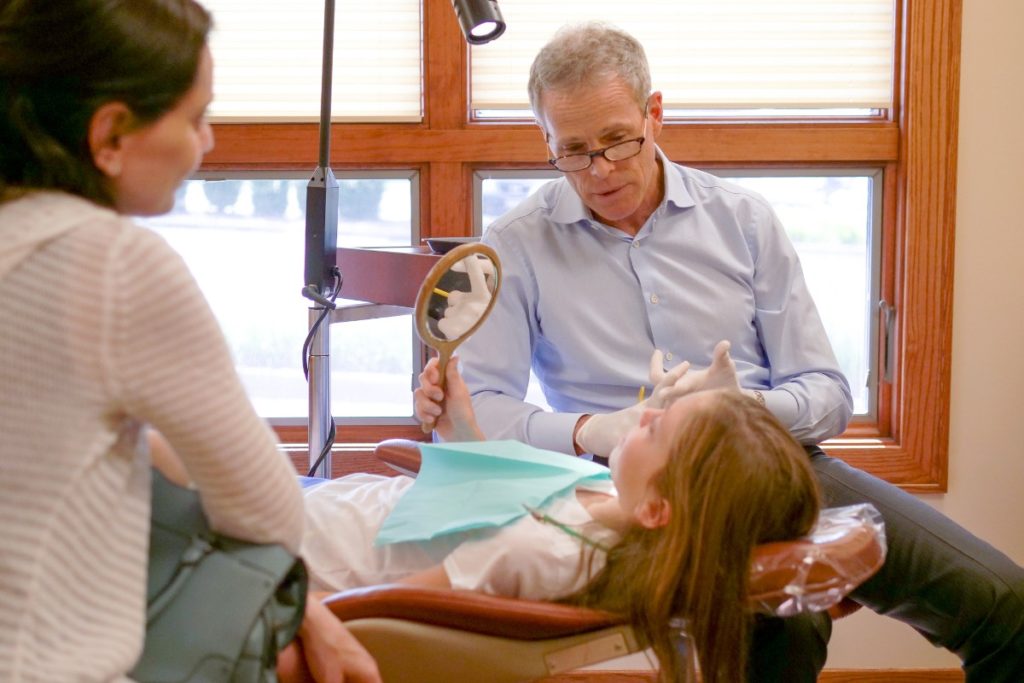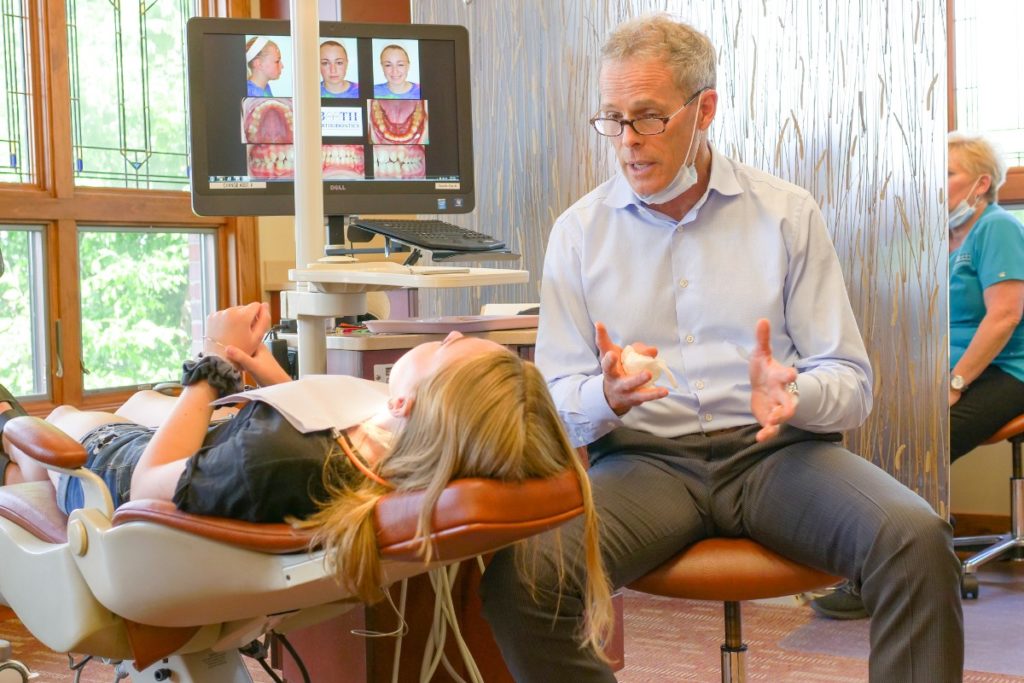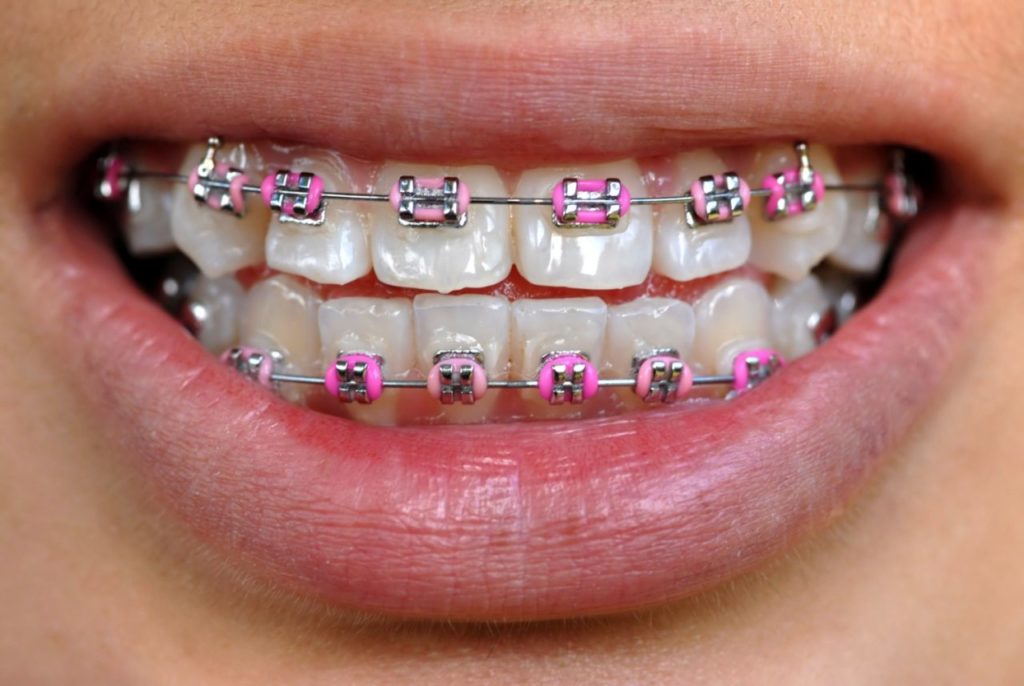When it comes to creating beautifully aligned smiles for patients of all ages, traditional braces are one of the best tools we have. Braces have been a standard treatment method in orthodontics for a long time, and have an impressive track record for straightening teeth, aligning jaws and teeth, and improving oral health overall!
When you make the decision to begin treatment with Booth Orthodontics, it can be exciting, but most patients have a few questions and concerns they want to go over before the braces are placed. We always want you to feel confident in the trust you’ve made from a mix of stainless steel, nickel, ceramic, or other high-quality materials. They have tiny hooks or doors over which the wire is threaded, and tend to be very durable. placed in our team, so we’ve put together an outline that includes everything you need to know before beginning orthodontic treatment. Keep reading below to learn more!
What are braces made of?
Brackets
Brackets are the part of braces we attach directly to your teeth. These are typically Brackets are secured by closing the door or by applying an elastic over the top of the wire.
Glue
Tooth glue is an adhesive used to attach the brackets to the teeth, and is technically a form of the same composite bonding material we use for tooth-colored fillings or sealants. In some cases, metal bands may also be used on the back teeth in conjunction with the glue. This gives braces more leverage and stability.
Wire
This thin piece of metal runs from one bracket to another. We change the shape and curvature of the wire throughout the treatment process, and this is what actively moves the teeth in the desired directions. For some patients, we will use the wire to attach all the bottom or upper teeth together. For others, we may choose to just cut the wire strategically if connecting only a few teeth makes more sense for the treatment plan.
Elastics
Elastics are an essential part of treatment for patients who need bite correction, although almost everyone will need elastics during some part of their treatment plan. Elastics are usually strung between an upper bracket hook and a lower bracket hook, pulling the upper teeth backwards to correct an overbite, or the lower teeth backwards to correct an underbite. We use rubber bands for many different situations, but they are especially useful when we want to bring the upper and lower teeth together successfully.
There are a number of other terms you may hear in connection with braces. These can include:
Orthodontic bands
These stainless steel rings are cemented to the teeth using dental bonding agents, providing an anchor for braces and other orthodontic appliances. These bands aren’t used with all patients.
Spacers
Spacers are small elastic “donuts” or rings that can be used to create tiny spaces in between the teeth when needed. This will typically happen before bands are placed. Spacers are sometimes also referred to as separators.

How does the treatment process work?
During your first visit to our practice, we’ll introduce you to some of our team and give you a brief tour of our Homer Glen office, and introduce some of the team. We will take diagnostic photos and x-rays if needed, and one of our doctors will perform a thorough examination before suggesting the best treatment options for your specific case. Once your questions have been answered and you’ve decided on a treatment plan, you’ll be scheduled for an appointment to begin the orthodontic process. This will generally be the day that your braces are put on, and as always, will be available to answer any questions or address any concerns you might have!
At Booth Orthodontics, we offer both traditional metal and clear braces. The care for both is similar. During the treatment process, you’ll be scheduled for regular follow-up visits with us. At these appointments, we’ll do any necessary adjustments, as well as check that everything is progressing according to the treatment plan. We value your time, and do our best to keep these appointments short so you can get back to work, home, or school as quickly as possible! But it’s important that you keep these appointments, as they are an essential part of your treatment and help ensure you get the best results in the least amount of time.
How to care for your braces
There can be a bit of a learning curve when it comes to caring for your braces, especially in the early days of having them. However, with a little patience and a lot of practice, you’ll be able to get the hang of it in no time! Your dental hygiene routine is a good example. While it’s important for all of us to clean our teeth and gums daily, it’s even more imperative for orthodontic patients in braces. That’s because food particles and other debris can become trapped in the nooks and crannies created by the braces, increasing the chance for cavities and tooth decay. To help keep your teeth and gums happy and healthy while wearing braces, we recommend the following tips.
Brush your teeth thoroughly at least two times per day with fluoride toothpaste, especially after meals and before bed. Pay close attention to the areas between the brackets and gums, carefully cleaning between the wires and teeth. Brush for at least two minutes each time, placing the tips of the bristles against the teeth, and using small circular motions. Scrub firmly to get rid of plaque!
Use a soft orthodontic toothbrush, or an electric toothbrush that comes with a soft bristled head. Interdental brushes can also be used to fit in between the wires and the teeth. These make it easier to remove hard-to-reach plaque and food debris. To help strengthen the tooth enamel, a mouthwash containing fluoride can be used in addition to regular brushing and flossing.
Flossing is an essential part of maintaining oral health, and it should be done at least once per day. Flossing regularly is even more important when wearing braces because food particles can get stuck in the tiny crevices around the brackets and in the gums. If you find regular floss difficult to manage, try a floss threader! This tool has been designed to help make flossing with braces easier. As the name implies, it works a little bit like threading a needle — one end of the floss is pulled through the threader and the threader goes under the archwire. This allows you to grab the floss on each end and slide it up and down both sides of the teeth and under the gums.
Oral irrigators like a Waterpik are also an excellent addition to the regular brushing and flossing routine. These instruments shoot small, high-pressure streams of water onto the teeth, targeting food debris and plaque that can form between the teeth and braces.

A note on food restrictions
For many patients, food restrictions can be one of the biggest challenges to come with braces. In order to protect both the appliance and the teeth, braces patients will need to avoid anything too crunchy or too chewy throughout the course of treatment. This includes things like chips, ice, gum, some raw fruits and veggies, popcorn, and many kinds of candy. Although this can be frustrating, try to remember that food restrictions are only temporary! All your hard work will be more than worth it when you see your brand new smile after your braces are removed.
Estimated treatment times
The most common question we hear from patients tends to be “how long will my treatment last?” Unfortunately, there is no “one size fits all” answer to this! Every smile is different and every patient responds to treatment in their own way, so the time spent in braces will vary on a case-by-case basis. On average, the active stage of orthodontic treatment can last anywhere from 6-24 months, but this can be longer or shorter, depending on the particular issues at play. Once this phase of treatment is completed, a retainer will need to be worn to keep your newly straightened teeth in place.
Take the first step towards a straighter smile Booth Orthodontics
The first step in any orthodontic journey is a consultation with an experienced orthodontist. Drs. Barry and Ryan Booth have many years of combined experience between them, and are known throughout the community for creating a beautiful smile for patients of all ages! If you’re in Homer Glen or the surrounding areas and would like more information on how braces can give you a healthier, more attractive smile, get in touch with us today to schedule a FREE consultation. This is the perfect time to get the smile you’ve always wanted!
 Dr. Ryan Booth
Dr. Ryan Booth